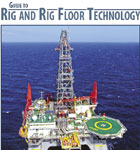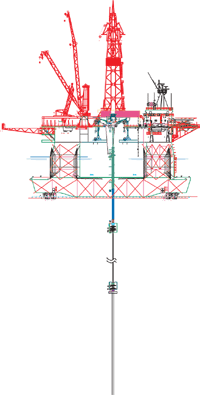Rig floor equipment: Surface stack operations
December 2004 Supplement Rig Floor Equipment Surface stack operations
Surface stack operations
Pride International, Inc. is marketing the Amethyst class rigs, Pride Rio de Janeiro and Pride Portland, for use on wells that are potential candidates for surface stack operations. These rigs were designed and built for the Petrobras 16-3/4-in. wellhead systems, using 18-5/8-in. riser; and, while this may reduce their appeal to the wider market, it makes them suitable for the possible surface stack arena. They can run their conventional subsea BOP stacks onto these wells, in as much as 5,500-ft water, saving modifications to convert a rig to use a surface stack system while benefiting from the slim-hole techniques. The riser has an ID of 17-3/8 in. which allows operations on 16-3/4-in. or smaller wellheads, thus presenting options. The present procedure is to run 30-in. casing and then 16-in. casing on a 16-3/4-in. wellhead. The stack is run before drilling 12-1/4-in. hole, and running 9-5/8-in. casing, etc. The surface stack method is to run 13-3/8-in. casing to a conventional subsea (18-3/4-in., 16-3/4-in. or 13-5/8-in.) wellhead at the seabed, then land a subsea disconnect device on that wellhead, tied back to a surface BOP stack, using 13-3/8-in. casing as a riser. The subsea disconnect device allows the drillstring to be hung off and sheared so that the riser/ casing can be safely disconnected in an emergency. Well control is performed with the surface BOP stack equipped with one annular BOP and three rams, together with the choke and kill valves, etc. The Amethyst vessels pose an additional challenge in trying to adopt a surface BOP configuration due to the limited space under the rig floor. To overcome this, Pride developed a concept where the surface stack is operated just under the hull, away from the splash zone, safe from wave action and, more important, enhancing safety by allowing use of a full conventional telescopic joint to provide protection from potential riser recoil in the event of a catastrophic riser failure. This method also precludes need for a big guidance frame for the BOP stack in the moon pool. Wells drilled by these techniques have been coined many different names by their designers, slender X, QED, SX, Dipstick Drilling, etc. The commonality is that they are considered to be exploration wells where the intent is to arrive on location, drill the well quickly and move on. Finds are followed up, and completed, from a spar, a TLP, or by use of a subsea BOP stack. As these Amethyst rigs are DP Class 3, they also allow for time saving at the beginning and end of each well by being ready to commence operations as soon as they arrive. These rigs could be used “as is” to begin a drilling program in up to 5,500-ft water, while the surface stack equipment is being built and tested. When installed, the water depth capability could be 7,500 ft or more. |
|||||||||




